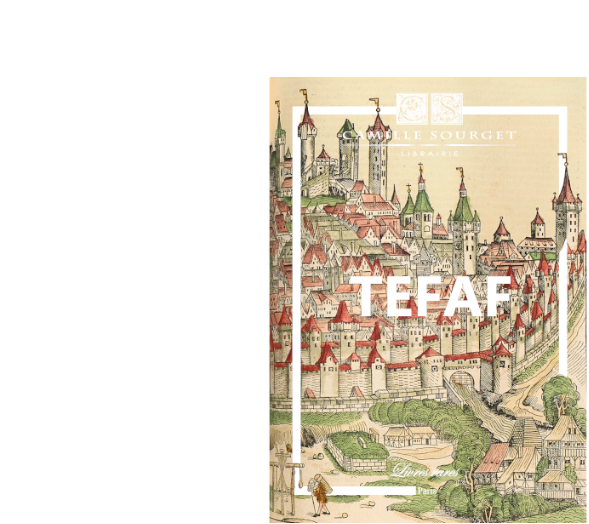Remarkable partly original collection
– of notable rarity (edition unknown to Brunet and Deschamps) –
of 101 models of historiated alphabets and Gothic ornaments printed in Venice in 1575.
In Venice, 1575.
Amphiareo da Ferrera, Vespasiano. Work of brother Vespasiano Amphiareo Da Ferrara of the minor conventual order, in which it teaches writing various types of letters, & especially a letter bastard newly discovered by him, which serves for Chancery & Mercantile.
Venice, 1575.
Oblong in-8 of (110) pages – complete – 7 ff. outer white margins restored without affecting the letters. Full brown morocco stamped with blind tooling, spine with raised bands, gilt edges. Binding by Lobstein-Laurenchet.
145 x 204 mm.
Partly original edition of notable rarity – unknown to Brunet and Deschamps – of this collection of 101 models of historiated alphabets and Gothic ornaments by Vespasiano Amphiareo (1501-1563).
Important and famous treatise on the art of writing in the 16th century, composed by Vespasiano Amphiareo, a student of Tagliente and a writing master in Venice for thirty years.
The collection, initially published in Venice in 1548 under the title Un novo modo d’insegnar a scrivere, in this augmented edition gathers 101 models of alphabets of bastard letters, gift letters, Gothic characters, monograms, fantasy or geometric writing, etc., all finely wood-engraved.
« Calligrapher, native of Ferrara, lived in the 16th century, religious in the Order of Conventual Minor Friars. The known information about him is uncertain and contradictory. The oldest records state him as dead at sixty-two in 1563, but further information about his activity suggests instead that his birth was earlier around the year 1490.
It seems he came from the Albertazzi or Albertacci family, which ended with him: it is not unlikely that his baptismal name was Alfonso, as Franchini registers him thus; Vespasiano would be the name assumed in religion and A. an academic nickname of clear classical inspiration.
While still very young, A. went on to teach calligraphy in Florence, but by 1518 he was already in Venice, where he carried out most of his activity and where he probably died. He wrote: Un novo modo d’insegnar a scrivere et formar lettere di più sorti che da altri non prima c’hora usate: novamente da frate Vespasiano minoritano trovato e da lui pur hora dato in luce, Vinegia, per Curtio Troiano di Navò, 1548, in-4° (with woodcut figures): two pages of the book contained a dedication to Francesco Donati, Doge of Venice.
Six years later, still in Venice, “at Gabriel Giolito de’ Ferrari and brothers,” the Work by Brother Vespasiano Amphiraeus from Ferrara of the minor conventual order, in which he teaches to write various kinds of letters, and especially a “bastard” letter newly invented by him with his industry which serves for chancery and mercantile purposes; then he teaches how to make the blackest ink with such ease that everyone, no matter how simple, will know how to do it by themselves. Also how to grind gold and write with it as you do with ink, likewise to write with azure and cinnabar, a most useful work and very necessary for human use (in-4° obl., with figures). Despite the different title, this second pamphlet was little more than a reprint of the previous one, so much so that it retained the dedication to the doge Francesco Donati, although he had died in May of the previous year. Various editions are cited thereafter, some with the publisher’s indication, others without: 1555, 1556 (by Comin da Trino), 1565, 1572, 1575, 1580 (by Alessandro Gardano), 1583 (by il Cavalcalovo), 1588 (by Gio. Antonio Rampazetto). Starting with the 1572 edition, two more alphabets appear in the manual than in previous publications; it is likely they were added on this occasion by A. himself and that hence the date of death should be delayed from 1563 to a year around 1572. A probable reduction of the same work is the Method and Exemplar for writing in capital letters, published in Venice in 1589 and still with the dedication to Doge Donati, which Franchini remembers as Amphiareo’s only writing. Nor was it anything more than a new presentation of the same book The Perfect way to learn to write all types of chancery, cursive and modern letters, which serves every condition of Persons. With the method of letterhead for missive letters for every degree of people. The way to make the most beautiful ink. With learning to grind gold and to write with it, etc., printed in Venice, near Lissandro de Vecchi, in 1620.
La fama di cui l’A. godette presso i contemporanei e nei secoli successivi è fondata soprattutto sulla elaborata ricercatezza dei suoi alfabeti maiuscoli di tipogotico, dove l’ornato raggiunge preziosità. incredibili, che finiscono in taluni casi colnascondere le linee strutturali dei singoli. segni. Viceversa maggior merito gli va riconosciuto per l’elegante semplicità della. sua “bastarda”, da lui stesso chiamata. “bastarda del Frate”, di cui a ragione si vanta: “havendo per arte et industria mia. nuovamente ritrovato una forma et un caractere di lettera, che bastarda si chiama, e la quale quasi un corpo mistico de la natura, di molte participando, mi pare, che ad un medesmo modo, per essere, lunghetta e vaga, posi aconvenirsi al Cancelliero: et per esser corsiva, et espedita, sia buona per lo Mercatante”. In essa l’A. fonde con sobria finezza elementi di scrittura mercantile in uso a Firenze con altri in voga a Venezia, ma tenendo altresì presenti i caratteri aldini. Meno originali sono invece le lettere che chiama “di bolle”, cioè per atti solenni, e che ripetono le forme della più rigida gotica libraria. » [Par Alessandro Pratesi, Dictionnaire biographique des Italiens, volume 3 (1961)].
Partially original collection of the most distinguished rarity.

